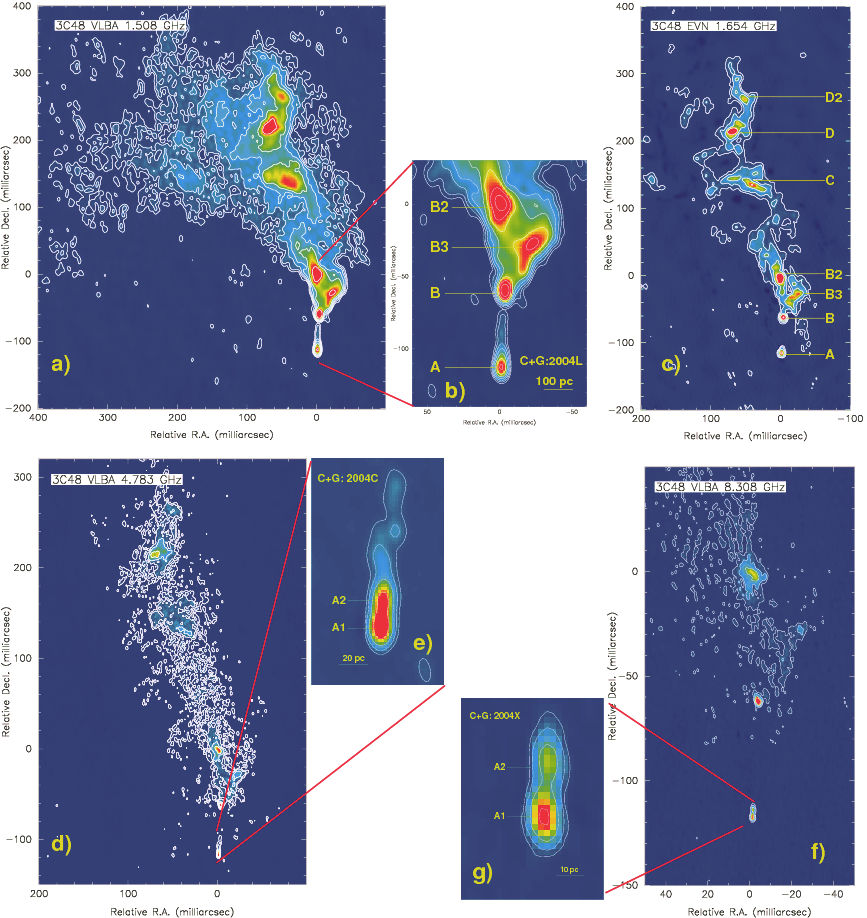Daily Image
31-03-2010Tomorrow's colloquium: VLBI observations of the CSS 3C48 and five GPS sources (Tao An, Shanghai Astronomical Observatory)
| Submitter: | Stefanie Muehle |
| Description: | In this talk, I will summary the VLBI polarimetric observations of the compact-steep-spectrum quasar 3C48 made with the VLBA in 2004 and the EVN in 2005. We present high-dynamic-range images of the radio jet at various angular resolutions. The southernmost VLBI component A, which is previously identified as the core, is further resolved into two sub-components A1 and A2 at 4.8 and 8.3GHz, respectively. A1 shows a flat spectrum and harbor the active nucleus; A2 shows a steep spectrum and is associated with the inner jet. Comparison of the present VLBI observations with those done in 1984 results in an apparent transverse velocity 3.7+/-0.4c for A2. Combining the apparent jet speed and the jet-to-counterjet intensity ratio, a lower limit of the intrinsic jet speed is $v>0.85c$ and the viewing angle of the jet axis is less than 35 deg. We first present the VLBI polarization images of the 3C48 radio jet. The most strongly polarized VLBI components are located at component C, about 0.25 arcsec north of the galactic nucleus, where the jet bends to the north-east. The polarization angles at C show gradual changes across the jet width at all observed frequencies, indicative of a gradient in the emission-weighted intrinsic polarization angle across the jet or possibly a systematic gradient in the rotation measure. The brightest VLBI component B shows a higher rotation measure, and is not detected with significant proper motion. The observations suggest a stationary shock in the vicinity of B. The radio jet of 3C48 exhibits multiple bends from milliarcsec scales to arcsec scales. We modelled the oscillating jet structure with a simple precessing jet model and a helical-mode hydrodynamical instability (Kelvin-Helmholtz instability) model. Both kinematic models well fit with the bending shape, while more observations are to discriminate the two models. A new-run VLBI observations with the EVN and VLBA have been made on 2010 March 9th (18/21cm) and 21th (6cm). The new observations are useful for improving the accuracy of proper motion measurement in inner jet, and are important for constraining the kinematics of bright knots. Tracing the motion of the innermost jet component will test if the jet knot moves along a ballistic path as predicted by the precessing jet model. VLBI polarization data are helpful for understanding the jet-ISM interactions. I will introduce some recent work on five GPS sources observed with the EVN along with two new Chinese telescopes. ---------------------------- 2010, MNRAS, 402, 87 http://adsabs.harvard.edu/abs/2010MNRAS.402...87A Authors : T. An, X. Y. Hong, (1) M. J. Hardcastle (2,3) D. M. Worrall (3), T. Venturi (4), T. J. Pearson (5), Z.-Q. Shen, W. Zhao (1) and W. X. Feng (6) 1 Shanghai Astronomical Observatory, China 2 University of Hertfordshire, UK 3 University of Bristol, UK 4 INAF, Italy 5 California Institute of Technology, US 6 Liaocheng University, China |
| Copyright: | Tao An |
| Tweet |  |
